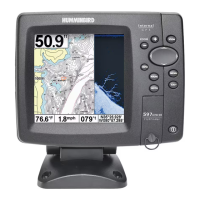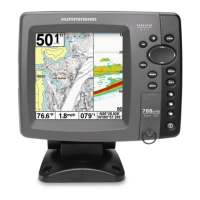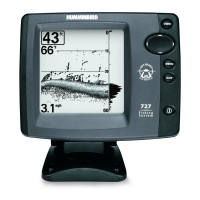
Do you have a question about the Humminbird 788ci HD DI and is the answer not in the manual?
| GPS | Yes |
|---|---|
| Waypoints | 3000 |
| Routes | 50 |
| Power Output (RMS) | 500 Watts |
| Power Output (Peak to Peak) | 4000 Watts |
| Target Separation | 2.5 inches |
| Temperature | Yes |
| Backlight | Yes |
| Mount Type | Gimbal Mount |
| GPS Receiver | Internal |
| GPS Trackplotting | Yes |
| Optional 360 Imaging | No |
| Humminbird PC | Yes |
| Upgradable Internal Software | Yes |
| Split Screen Zoom | Yes |
| Split Screen Bottom Lock | Yes |
| Large Digits View | Yes |
| Custom View Selections | Yes |
| Display Colors Grayscale | 256 Colors |
| Temperature Alarm | Yes |
| Chartplotting | Yes |
| Track Logs | Yes |
| Voltage Range | 10-20 VDC |
| Operating Temperature | -15°C to 55°C |
| Waterproof Rating | IPX7 |
| Display Size | 5 inch |
| Sonar Type | Down Imaging |
| Depth Capability | 1500 feet |
| Sonar Frequency | 455 kHz |
| Speed | Yes |
| Storage Temperature | -25°C to 70°C |
| Transducer | XNT 9 DI T |
Explains the 200/83 kHz sonar system with 60° coverage for wide area detection.
Details the high-definition scanning beams at 455/800 kHz for detailed structure.
Covers the XD transducer for extreme depth coverage up to 2500 ft.
Describes the wide 90° coverage and side structure beams for fish detection.
Explains the specialized side-looking transducer for bank fishing and open water.
Details the integrated transducer in Minnkota trolling motors for sonar data.
Describes the purpose and operation of the various control head keys.
Explains using SD cards for charts, software updates, and data export/import.
Describes expanding functionality by connecting compatible accessories.
Explains how sonar data is represented on the screen.
Details how colors represent sonar return intensity and bottom types.
Controls how sonar returns are displayed with Max and Clear modes.
Allows pausing the display and moving a cursor to analyze sonar returns.
Explains how Down Imaging™ images are produced and interpreted.
Guides on using light and dark parts to understand objects under the boat.
Controls the display of sonar returns for clarity and detail.
Presents a historical log of sonar returns with recent data on the right.
Produces detailed sonar data from high-definition profiling beams.
Displays cartography with current track, waypoints, and routes.
Splits the screen into Chart View on the left and Sonar View on the right.
Explains storing and organizing navigation points like waypoints and tracks.
Guides on setting up navigation to a specific point or waypoint.
Describes creating and managing saved paths between waypoints.
Explains saving and viewing the boat's past path as trackpoints.
Selects operating modes like Normal, Simulator, System Status, or PC Connect.
Provides quick access to frequently-used settings relevant to the current view.
Provides shortcuts and navigation advice for the Main Menu.
Simplifies or expands menu options for user preference.
Accesses frequently-used Sonar settings for quick adjustments.
Provides quick access to Down Imaging™ settings.
Offers quick access to frequently-used Navigation settings.
Configures various audible and visual alarms for fishing conditions.
Accesses detailed Sonar settings like Beam Select, Sensitivity, etc.
Manages system settings like Units, User Mode, Time, and Display formats.
Troubleshoots issues with the unit not turning on, checking power connections.
Identifies and resolves common issues affecting screen information quality.
Diagnoses and mitigates electrical or mechanical noise interference.
Lists technical details including depth, power output, and frequency for the 788ci HD.
Lists technical details including depth, power output, and frequency for the 788ci HD DI.
Lists technical details including depth, power output, and frequency for the 788ci HD XD.
Defines key terminology related to sonar technology and operation.
Defines key terminology related to GPS and navigation functions.











